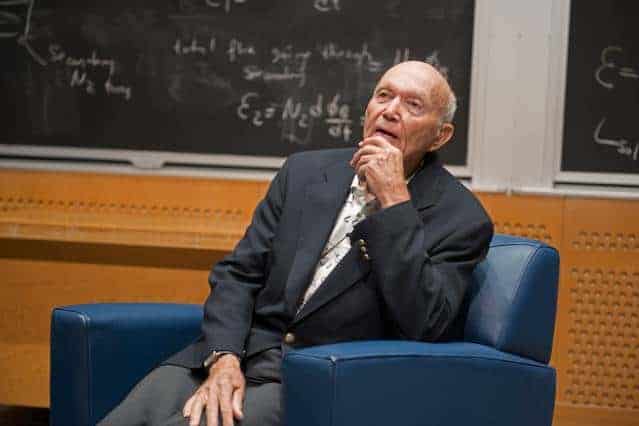Apollo 11 astronaut Michael Collins was part of the three-person crew that flew on mankind’s first mission to land on the moon, but he was the one who remained in orbit and never got to the lunar surface. In a talk at MIT yesterday as part of a class in the Department of Aeronautics and Astronautics (AeroAstro), Collins said that he probably could have had a chance to walk on the moon after all, had he chosen to remain at NASA after that epochal mission.
“What I gave up probably was the opportunity to be the last person to walk on the moon,” Collins said in response to a question from the audience. Although there was no guarantee, he said, under the rotation system for crew selection at that time, he would likely have been named as commander of the Apollo 17 mission, which turned out to be the last to visit the moon.
Instead, Collins retired from NASA and went on to other things: writing a bestselling book about his experiences, called “Carrying the Fire,” and becoming director of the Smithsonian Air and Space Museum in Washington. After the success of Apollo 11 in fulfilling President John F. Kennedy’s call to send a man to the moon and back before the end of the 1960s, Collins said, “My mindset was, ‘It’s over, we did it’.”
Collins, who also appeared at MIT last year as part of AeroAstro’s 100th anniversary celebration, was back on campus this week to speak to a class on the history of the Apollo program. The course, “Engineering Apollo,” is taught by David Mindell, the Frances and David Dibner Professor of the History of Engineering and Manufacturing.
A hero to many
“He’s a hero to many of us who have followed the world of Apollo,” Mindell said in introducing Collins. Among the numerous honors bestowed on Collins, Mindell said, perhaps the ones that would resonate most strongly at MIT were the naming of both an asteroid and a lunar crater after him. Collins’ book, Mindell added, is widely considered the best astronaut book from that era — or maybe ever.
Before flying the Apollo 11 mission, Collins graduated from the United States Military Academy at West Point, joined the Air Force, and became a test pilot, flying a variety of fighter jets. Though he had never anticipated flying into space, when President Dwight D. Eisenhower announced that U.S. astronauts would be selected from among qualified test pilots, Collins realized he was part of a select pool of perhaps 200 people, and decided to apply.
Prior to Eisenhower’s decision, Collins said, there were “a lot of crazy ideas” about how to choose astronauts, including suggestions for selecting people “accustomed to danger, including bullfighters,” or those used to having to breathe through special equipment, such as scuba divers.
Collins’ first mission was on Gemini 10, flying a two-person capsule that he recalled fondly as a “nice little flying machine.” On that mission, he became the fourth human ever to perform an “extra-vehicular activity,” or spacewalk.
The most challenging part of that mission, Collins said, was a first attempt at a rendezvous and docking between two spacecraft in orbit — an essential part of the preparations for the eventual lunar missions. “It was the rendezvous that probably bothered us more than anything,” he said, because of the technical complexity and risks of bringing together two vehicles flying in different orbits at high speed.
To train, the astronauts spent a lot of time in simulators, which faithfully reproduced the spacecraft’s interior and controls. That was a big improvement over preparation as a test pilot, he said, where there often were no simulators for the testing of experimental craft.
“I spent probably 600 hours in one simulator” while preparing for the Gemini mission, Collins said, in addition to many hours in other simulators. Overall, he said, “We were pretty well prepared” for both the Apollo and Gemini flights.
Basketballs and dancing
Asked about MIT’s role in producing the guidance system for the Apollo program, Collins recalled meeting Charles “Doc” Draper, then head of the MIT Instrumentation Lab, who was responsible for that system. “When I think of the instrumentation lab, I think of a basketball and ballroom dancing,” he said.
The “basketball,” he explained, was the heart of the inertial guidance system — a sphere that contained a timer, three gyroscopes, and three accelerometers. “You told it what time it was, and where it was,” he said, and “it knew where you were, and where you were going. That was the heart of Apollo.”
As for the ballroom dancing, he said, that referred to Draper himself — who, despite the hectic preparations for the lunar mission, “would disappear for weekends, and come back with these trophies for ballroom dancing. I thought that was so cool!”
Collins’ talk was open to the MIT community. He was asked about contingency planning in case the other two astronauts, Neil Armstrong and Buzz Aldrin, had been unable to return from the moon’s surface — which could have happened due to any number of malfunctions.
In that event, Collins said, “I’d go home,” leaving the others behind. “They knew that, and I knew that, but it’s not something we ever talked about. What’s the point?”
As for the future of the space program, Collins was emphatic: “I think NASA should be renamed NAMA,” he said. “They ought to make [Mars] their one overriding goal and destination.”


